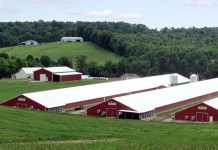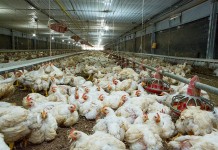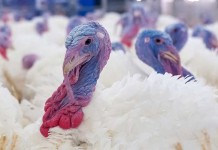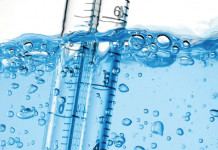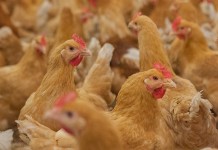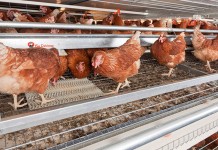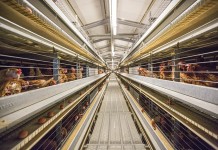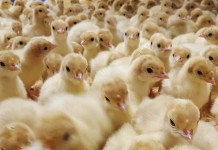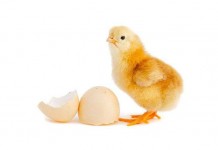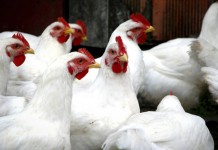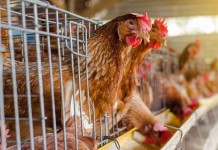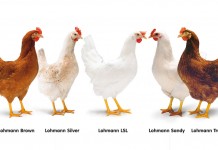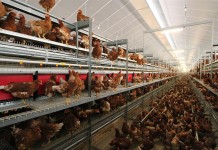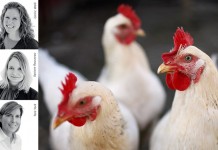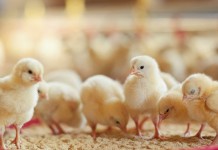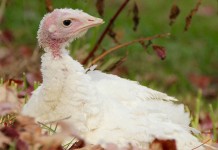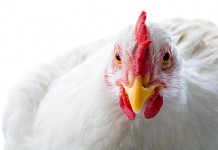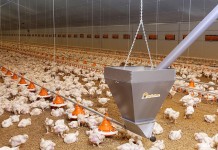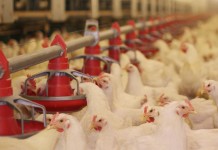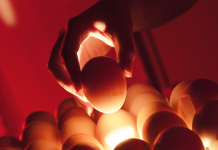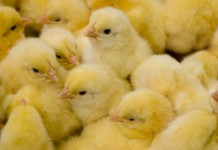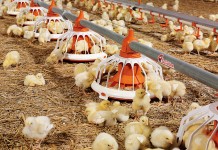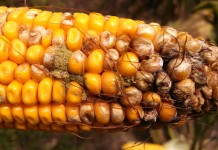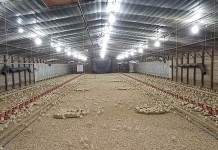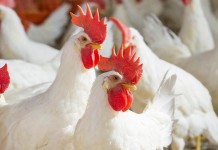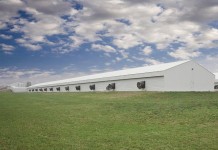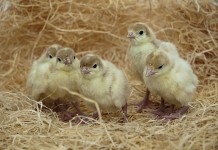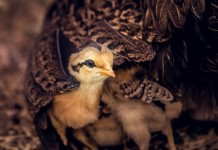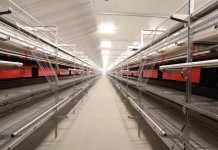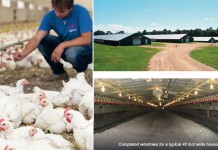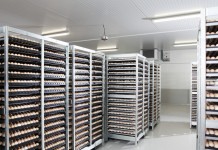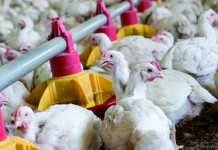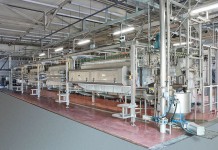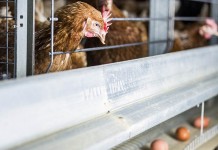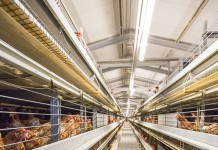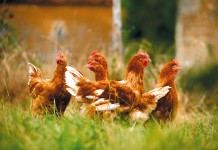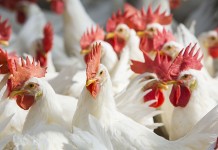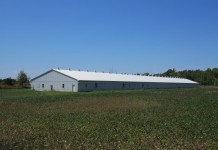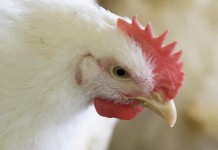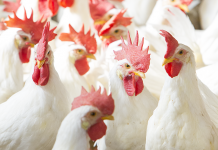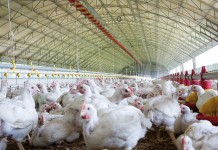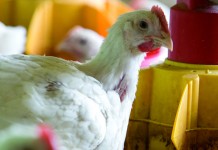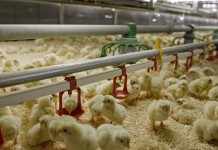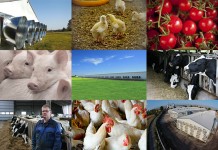Exterior and interior strategies for rodent control
As the weather cools, rodents seek refuge indoors where there is easy access to food and water. Rodents are vectors for spreading disease, which...
Re-stored turkey eggs outperform untreated eggs stored for 8 to 15 days by 7%
By using heat treatment during storage up to 14 days, as part of your standard hatchery practice, it is possible to gain up to...
Performance benefits of probiotic and protease in broilers subject to Eimeria challenge
Consumer pressure and government regulations are driving US poultry industry to remove antibiotic growth promoter (AGP) from poultry production.
Nutrition program including feed additives is...
Dietary non-phytate phosphorus levels for laying hens in the last phase of lay
The phosphorus (P) requirement of laying hens is an area of on-going debate and it is a factor that contributes to hen performance and...
Antibiotic-Free turkey production
The production of turkeys without the use of antibiotics is an increasingly common goal across the globe due to the focus on antimicrobial resistance....
Healthy water, healthy birds
Since birds consume as much water as feed providing a clean, safe and sanitized water supply is crucial for assuring modern poultry flocks perform...
Aviagen slower-growing breeds get seal of approval from key European welfare schemes
Europe is experiencing an increase in demand for slower-growing breeds. The momentum of this poultry market sector is likely to follow on an upward...
Practical applications of nutrigenomics in poultry nutrition
Novel molecular techniques such as microarray technologies have spurred the development of the field of nutrigenomics.
Using microarrays to evaluate gene responses allows us to...
Laying hen nutrition for optimizing egg production and quality
Hen nutrition is important; during the initial period of pullet rearing (<45 days of age), small particle size obtained by grinding of main cereals...
Field experience on the use of probiotics in chickens and turkeys
Probiotics have been used for several years in an attempt to improve intestinal health. Recently, microbial products have been extensively studied as supportive treatments...
Water holding capacity in poultry breast meat
Water holding capacity (WHC) is defined as the ability of meat to hold its inherent and added moisture during fabrication, processing, and storage.
Housing systems in laying hen husbandry- First part
A status report
This analysis is an abridged version of a report which the author prepared for the International Egg Commission (IEC) in London, UK.
In...
Dekalb White hens to be first occupants of innovative layer house
Environmentally friendly farm with lots of innovations
Four Dutch entrepreneurs are set to build an innovative new layer house in the south region of The...
Understanding poultry lighting
A short guide to poultry lighting for layer farmers
Review of different day-old chick quality parameters in layer type breeds – Part 2
The aim of every commercial layer hatchery is a maximum hatchability of first quality chicks. The evaluation of chick quality in the hatchery provides...
Turkey hatcheries – The past 25 years and the future of single-stage
A quick time travel back to a turkey hatchery in 1992 might show you a frazzled hatchery manager frantically trying to get eggs trayed,...
Hatchery waste management
There are various options for hatchery managers to convert their waste into value-added products such as compost, fertilizer, liming agents for soil amendment, biogas, medical products, and animal feed. This article explores some of these options.
On free amino acids – Their role in starch and protein digestive dynamics
The quantity of glucose and amino acids absorbed from the small intestine is a function of dietary concentrations, feed intakes and digestibility coefficients. Moreover,...
Better than alternatives to antibiotics
Many poultry flocks require antibiotic treatment, if not every cycle, regularly. Antibiotic alternatives are in great demand, especially in the context of dysbiosis and...
Latest innovations and future advances in genetics at Lohmann Tierzucht
The 53rd Lohmann Tierzucht Franchise Distributor provided an opportunity to review the latest innovations in genetics and genomics. Prof. Dr. Rudolf outlined the main points of the company strategy in breeding.
Housing systems in laying hen husbandry – second part
A status report
This analysis is an abridged version of a report which the Author prepared for the International Egg Commission (IEC) in London, UK.
In...
Scientifically validated results to raise poultry production profitability
The Poultry Science Association 2017 Annual Meeting took place in Orlando, Florida on July 17-20. Being the most prestigious scientific event for poultry in...
A new view of how class I molecules fight diseases
Classical class I molecules of the major histocompatibility complex (MHC) play crucial roles in defence against viruses.
The class I molecules bind pieces of protein...
New applications such as superdosing of phytase to maximize phytate destruction to improve performance...
It is well documented that phytase supplementation in broiler diets improves P and Ca utilization through the destruction of phytate (IP6) and thereby allows...
Novel Approach Improves Poultry Welfare by Reducing Stress on Chickens
MSD Animal Health (known as Merck Animal Health within the United States and Canada) recently announced the launch of EXZOLT® (fluralaner), the first systemic...
The effect of microbial challenge on the intestinal proteome of broilers
In broiler production intestinal health and function is paramount to achieving efficient feed utilisation and growth.
Uncovering the localised molecular mechanisms that occur during the...
The relationship between sperm function and diet – Toms are what they eat
It is well known that cryopreserved semen could be used to regenerate commercial or research poultry lines; however, fertility rates from poultry semen frozen...
BBSRC launch the Agriculture and Food Security Strategic Framework
The new framework identifies the key research and innovation priorities of the Biotechnology and Biological Sciences Research Council.
The new BBSRC’s Agriculture and Food Security...
Bacillus Subtilis improves performance of broilers fed medicated or non-medicated feed
Animal digestive health is key to obtain optimal performance. Antibiotic growth promoters (AGPs) have long been shown to be very effective to develop and...
SPIDES, short periods of incubation during egg storage
Why SPIDES is so important in incubation? If hatching eggs are stored for more than a week before being set in an incubator their...
The relationship between feed particle size, gizzard development and broiler performance
Anatomy of the stomach
The stomach of the chicken consists of two chambers, the proventriculus or glandular stomach and the gizzard or muscular stomach.
The proventriculus...
New technologies in housing, equipment and computer controls
The poultry housing and equipment industry continues to develop, introducing new technologies in line with trends in modern communications and ventilation systems. As expected...
SKA alternative layers farming
SKA of Italy offers a wide range of solutions for layer farming, ranging from aviary systems to communal nesting systems. Each one proven and tested to deliver excellent field results.
The impact of raised incubation temperature on hatch, chick quality and broiler performance
Two experiments were conducted at the Aviagen product development center in the USA to study the effect of increased eggshell temperature during mid to late incubation on hatchability and chick quality
The effects of in-ovo feeding
In-ovo feeding is a key issue in poultry. The embryonic and immediate post hatch developmental period represents a significant phase in attaining quality broiler...
Flexible Feed Formulation with GALLIPRO
Facing challenging goals
The goal of the poultry industry is to provide consumers with safe food, while promoting poultry health and welfare, in addition to carefully...
Feed borne mycotoxins: the threat to poultry?
Mycotoxins are metabolites produced by molds (fungi) that can infest crops pre-harvest and can continue to flourish under sub-optimal storage conditions. Grains with high...
ProHealth, new solutions for animal health and production sustainability
The ProHealth project is focused on understanding the multi-factorial dimension of animal pathologies linked to production and use this to develop, evaluate and disseminate effective control strategies to reduce impact.
Modification of the chicken intestinal epithelial physical barrier in poultry by dietary factors
The intestinal epithelial physical barrier is the most critical element of maintaining an intact intestinal barrier and made up of a layer of columnar...
On-farm control of campylobacter
Campylobacteriosis, primarily caused by the consumption of contaminated chicken products, accounts for the majority of food poisoning cases in Europe and many other developed...
Measurement of true ileal calcium digestibility of meat and bone meal for broiler chickens
Currently, there is a move towards the use of digestible phosphorus (P) in diet formulations for poultry due to P excretion into the environment...
Turkey breeding – Where from, Where to? – Domestication of animals was a major...
All species of today’s domestic plants and animals followed an analogous pattern of multi-generational change influenced by humans. The modern populations of turkeys followed...
Measurement of energy utilization in chickens
Although corn prices have dropped from historic highs in the past years, energy continues to be one of the driving costs in poultry feeding....
The Salmonella initiative
An enduring challenge and reputational issue for the egg industry is caused by the presence of Salmonella enterica serovars (particularly some Typhimurium serotypes), which...
Managing coccidiosis in birds raised without antibiotics
For poultry producers to make a profit they must have healthy, uniform sized birds, make sure there are no real or assumed human health...
Comparison of wheat and maize-based diets on growth performance and meat quality of broiler...
Maize and wheat are a major source of energy in broiler diets. Generally, wheat-based diets are offered to broiler chickens in Europe, Australia and...
Energy-efficiency in pre-conditioning inlet air for setters and hatchers
Hatcheries are found in a variety of climates, from the hot, humid tropics of South East Asia to hot, arid zones in the Middle...
VALLI housing systems
VALLI’s products not only live up to everything they promise but, above all, the solutions provided by the Italian company take into account all the issues involved in order to meet the requirements of an increasingly conscious and demanding customers.
Enhancing biosecurity using flow analysis and Danish entry concepts
The term Danish entry is commonly used to describe entryways to livestock buildings that help people enter barns in a relatively bio secure way...
Testing day-old poults
When poults are received at a farm from the hatchery they should be good quality poults; namely, free from physical defects, actively looking for...
Monitoring of IBV circulation and prevalence
Infectious bronchitis (IB) is one of the most common viral diseases in chicken production worldwide and IB virus (IBV) is considered the most contagious...
Optimal fat utilisation by Intra Liposol at broilers
It is difficult - especially for young animals - to optimally digest the range of fats and oils in the diet. This leads to...
In vivo digestion of GM proteins in laying hens
Despite all of the positive effects of modern technologies to improve corn and soybean yields, the consumer often has a different perception of the...
Separating welfare facts from fiction
It has become a confusing market for customers to decipher which technologies offer the best welfare-friendly solutions for their animals. How do you separate...
Jansen Poultry Equipment: the perfect solution for cage-free egg production
Consumers demand for cage-free egg production is growing worldwide. Europe already adopted cage free egg production systems and it seems that the US is following rapidly starting with Oregon, Washington. Also in New Zealand and Australia animal welfare is a main topic of discussion.
Impact of investment in Hendrix Genetics’ breeding and testing program
With the upcoming release of the new performance standards for Hendrix Genetics’ laying hens, it is important to examine factors contributing to the genetic...
Effects of light intensity on broiler welfare, productivity and leg health
Researchers investigated the welfare implications of behavioural changes induced by varying light programs. Here the effects of light intensity on broiler welfare and productivity are reported.
Windrowing properly done
Windrowing litter between flocks has been used commercially since the 1980’s and continues to evolve to meet numerous production challenges. The goal is to...
Physiological zero in hatchery management
On the farm, the eggs cool down after laying and are either transported on the same day or stored for a few days before...
Using more bioavailable sources of trace minerals pays off
A study of broiler breeder performance was conducted using three separate minerals programmes. The objective was to determine if productivity could be maintained at...
Prevention of cross-contamination in the hatchery
How to properly prevent cross-contamination in the hatchery. Here some easy steps to achieve a better biosecurity in your hatchery.
Meyn quality slaughtering
MEYN is the reliable and committed partner of renowned poultry processing companies in over 90 countries worldwide, with people having the right professional skills...
Evaluating hen behaviour and physiological stressors during Ventilation Shut Down
USPOULTRY announces the completion of a funded research project at North Carolina State University in Raleigh, N.C. in which researchers provided insight on using...
Raising broilers antibiotic-free
Best management practices are a key component in raising chicken without antibiotic with more attention to details of production and biosecurity.
Light intensity and led lights
Light intensity can be measured in three ways: luminous intensity, luminous flux and luminous power. Led Lights are here analyzed.
Luminous flux is the total...
ERPA, the European rural poultry association to defend rural poultry producers
Rural poultry production is important in volume and has a large social role; it was therefore essential to have a specific organization to represent...
Optimal outdoor stocking density in free-range hens
Consumer concern for laying hen welfare is leading to an increase in alternative housing systems that provide valued resources designed to cater to hens’...
Evaluating phosphorous equivalency of phytases
The use of exogenous enzymes in non-ruminant nutrition is a valuable tool to increase digestibility and therefore spare the inclusion of expensive nutrients whilst...
Update on Infectious Bronchitis in the United States
Infectious bronchitis infections continued to increase this year in the Ontario broiler, broiler breeder and layer sectors.
Infectious bronchitis virus (IBV) can be spread by...
Broilers perform better with intermittent lighting programs
Roles of certain parts of the digestive tract of chickens seems to have been lost with the evolution of time and commercial practices. Gizzards...
The role of feed additives in the protozoal diseases in poultry
Coccidiosis and histomoniasis are economically significant diseases in chickens and turkeys. Management, vaccination and medication are key tools in the control of these diseases...
Officine Facco, alternative systems for “cage free” layers
Facco offers practical, economical and environmentally-friendly solutions for the world wide poultry industry through a complete line of poultry cutting-edge technology equipment.
Hatcheries data collection and analysis
Hatcheries collect large quantities of data to monitor performance and to make sure equipment are operating within set operating limits.
These data are a valuable...
The effect of on-range insect feeding on range usage of free range laying hens
In Australia, on-range feeding of free-range laying hens can be frequently observed and is especially common in mobile sheds. While the biosecurity risk of...
High levels of cottonseed meal supplemented with composite microbial enzymes
Effects of cottonseed meal supplemented with composite microbial enzymes on broiler chickens.
Soybean meal (SBM) is the premier plant protein source used by the poultry...
Effectiveness of a double choice test to assess dietary taste preferences in broiler chickens
Investigations into the taste system of chickens can help to improve poultry feeding strategies. However, a comprehensive study on dietary taste preferences for broilers...
A practical approach to broiler breeder management in the absence of beak treatment –...
In the absence of beak treatment adhering to proven and agreed best practice management practices is key. The roles of good stockmanship and promoting...
Phosphorus: how low can we go in broiler diets?
Phosphorus (P) is essential for all forms of life. Dietary P content either in excess of, or below requirements may adversely affect broiler performance....
How to reduce antibiotics in broiler production?
There is an increased awareness recently in relation to the sensible use of antibiotics within poultry and livestock production. When looking at broiler production,...
Feed Conversion Ratio optimized for farmer profit
The farmers’ cost for animal feed is one of the main expenditures consisting of 60-70% of the overall producer costs. These producer costs are...


